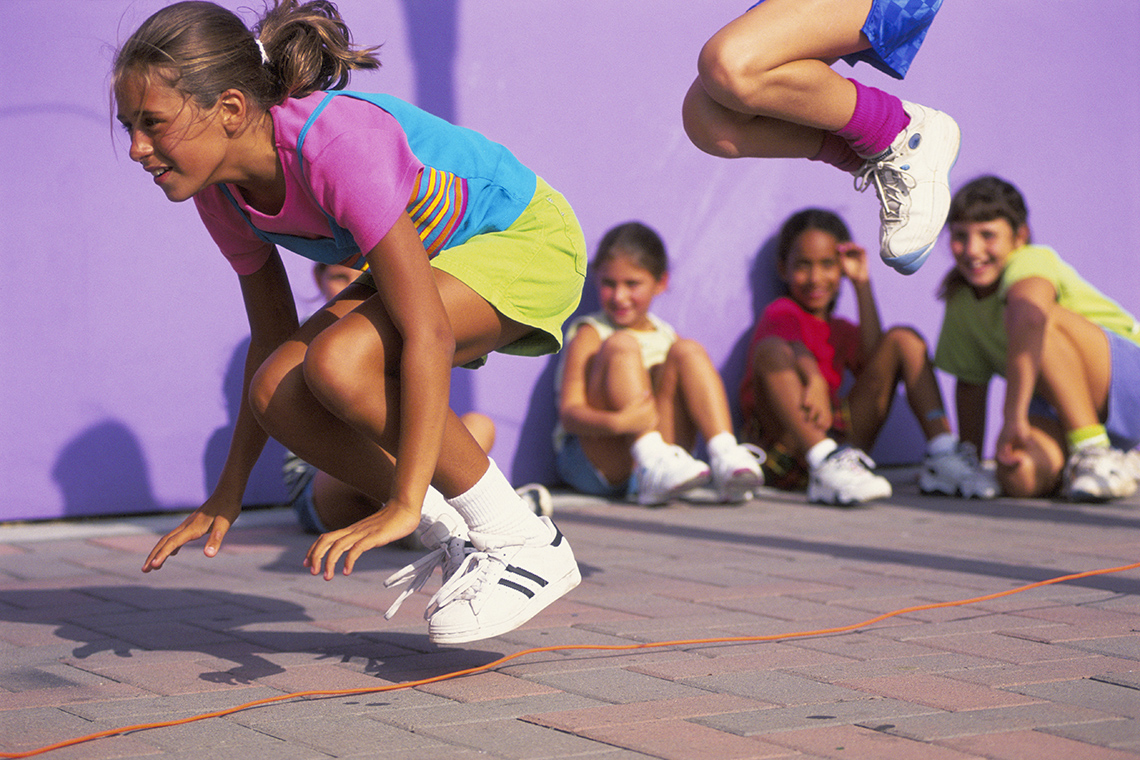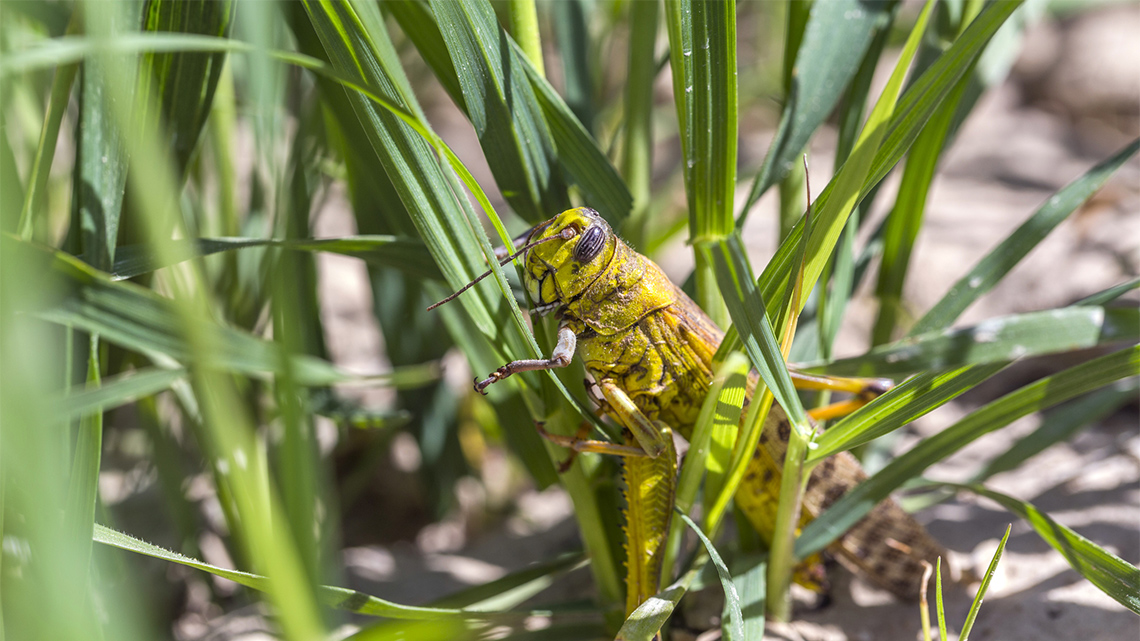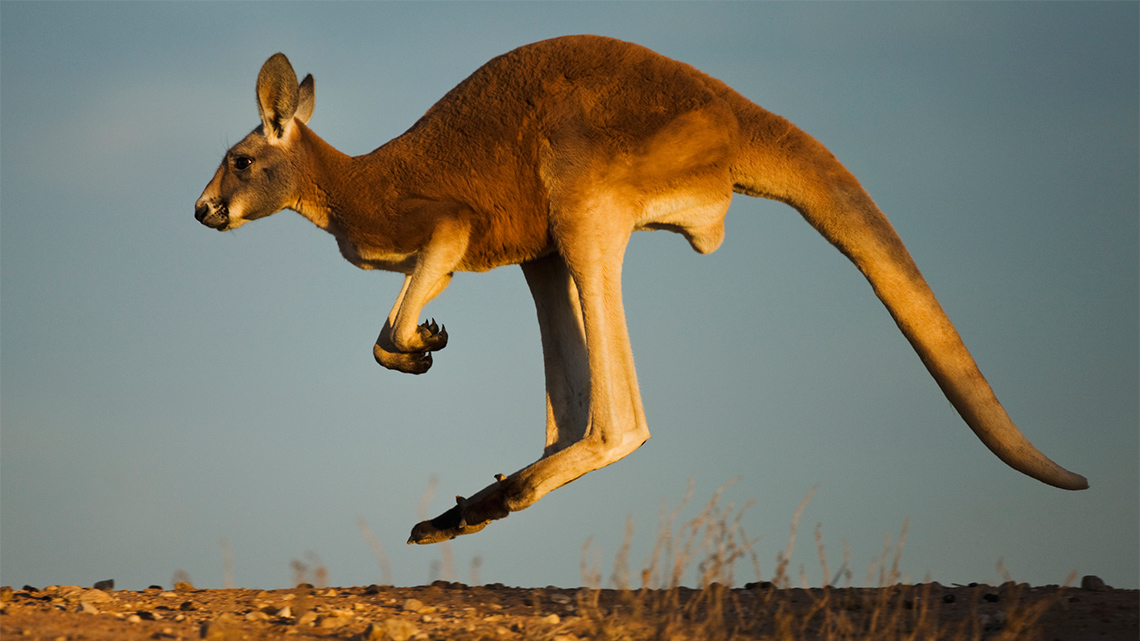Minds On
Observations
Explore the following images and descriptions of animals. After examining each animal, what do you notice?
After examining each animal, what do you notice?
Press ‘Hint’ if you need help getting started.
What action are the animals doing?
A jump is a movement with two feet or one foot.
The movement includes a takeoff, a flight, and a landing phase.
Brainstorm
What do you think?
Consider the following:
- What are a few situations when animals may jump?
- When do you think people may need to jump?
- What parts of the body do you think are needed in the action of jumping?
Record your ideas in a notebook or another method of your choice.
Action
Jump and land
Jumping and landing are skills that we use in many different activities. We will explore strategies and activities to help practise and control our jumping and landing skills.

But first, let’s start with a warmup activity to keep our muscles and joints flexible.
Safety
Before you begin:
Warm Up
Stretch it out!
Let’s try to follow along with these warmup movements! Explore this video entitled “Power Up: Outer Space 2” to follow along with an outer space themed workout.
Move and jump
Always be sure to do your safety checks!
1. Choose a movement. You can choose to walk, run, skip, dance, or whatever movement you enjoy doing!
2. Move around your space or room. Start counting from 1 to 5.
3. Then at 5, if possible, try to jump, and restart your counting from 1 again.
Repeat steps 2 and 3 for a few minutes.
Strategies
Press the tabs to explore the following steps and strategies for jumping and landing.
Explore this video to access a two-foot jump.
- Bend your knees and move into a crouch position.
- Swing your arms back.
Steps 1 and 2 are known as the takeoff phase for a jump.
- Push off from your toes and jump forward.
- Use your arms to pump yourself ahead and look forward.
Steps 3 and 4 are known as the flight phase when jumping.
- Land softly with your knees bent and both feet on the ground.
- Hold a squat position.
Steps 5 and 6 are known as the landing phase when the jump is complete.
Press the tabs to explore the following steps and strategies for a one-foot jump.
Explore this video to access a one-foot jump.
- Stand with one foot and bend the other leg’s knee.
- Swing your arms back.
Steps 1 and 2 are known as the takeoff phase when jumping.
- Push up, and jump!
- Use your arms to pump yourself ahead and look forward.
Steps 3 and 4 are known as the flight phase when jumping.
- Land softly with knees bent.
Step 5 is known as the landing phase when the jump is complete.
Phases of a jump
Jumping includes a takeoff, a flight, and a landing phase.
Using the strategies we previously explored, sort the strategies and steps as a takeoff, a flight, or a landing phase.
For each term select the corresponding image.
Jump for distance
Task 1: Up and far!
Now, it’s your turn to jump and land.
Use the strategies and steps to jump for different distances.
Press the following tabs to access the jumping and landing activity.
Always be sure to do your safety checks!

- tape or chalk
- timer
- pen and paper

A floor with three different lines of tape at a different distance. A learner jumps towards the piece of tape with the shortest distance with two feet off the ground, while a peer records the time on a piece of paper. Another learner jumps towards the piece of tape with the shortest distance with one foot off the ground, while a peer records the time on a piece of paper.
- Use tape, chalk, or another method of your choice to mark 3 different lines, each a different distance. You may have a peer/adult assist you.
- Try jumping and landing with a two-foot takeoff for your first marked distance.
- Time and record how long it took to reach the marked distance. For example: 5 seconds or 10 seconds.
- Then, with a one-foot takeoff, try to jump and land for your first marked distance.
- Time and record how long it took to reach the marked distance. For example: 5 seconds or 10 seconds.
Continue with steps 2 to 5 for the remaining distances with the two-foot and one-foot takeoffs.
Pause and Reflect
Pause and reflect
Explore the following questions:
- Which jump (two-foot or the one-foot) did you enjoy? Why?
- What did you find surprising about the activity? Consider the timing for the distances (two-foot or the one-foot).
Record your ideas in a notebook or a method of your choice.
Jump for height
We will also practise our jumps for height. Jumping for distance and for height are slightly different.
Jumping for distance is how far one can jump.
Jumping for height is how high one can jump.
Both have similar strategies, but the position of the arms during the flight and landing phase are quite different.
Let’s focus on each phase and explore the following strategies for jumping for height.
Task 2: Froggers
We are going to pretend to be hungry frogs looking for flies for this activity. Soft objects like beanbags will be our yummy flies!
Always be sure to do your safety checks!
Press the tabs to access the steps for this activity.

- tape or string
- soft objects (beanbags, sock balls, or crumpled paper)

A straight line on the ground with beanbags on either side. A student jumps high across the line and picks up one of the beanbags.
- Use tape or string to create a straight line on the ground.
- Scatter soft objects (beanbags, sock balls, or crumpled paper) on either side of this line.
- If possible, jump across the line as high as you can in a zigzag pattern as you move towards the objects.
- When you are close to an object, safely bend and pick it up.
- Carry the object back to the starting position in a zigzag pattern as high as you can.
Repeat steps 3 to 5 until most objects are collected.
Remember you can only carry one object at a time, and try your best to jump as high as you can!
Student Success
Think-Pair-Share
If possible, with a partner, discuss the following questions:
- Why might a person jump for distance?
- Why might a person jump for height?
Record your ideas in a notebook or another method of your choice.
Cool Down
Let’s stretch!
We’ll cool down with a few stretches. Remember to take slow and deep breaths during these stretches, as you allow the heart rate to return to a normal pace.
You may do either or both options.
Always be sure to do your safety checks!
Option 1: Quad stretch

- If possible, stand tall and shift your weight to your right leg.
- Lift your left foot back and hold it with your left hand.
- Pull the left foot towards your butt and feel the stretch.
- Hold the stretch if you can and repeat with the right leg.
- If possible, continue to stretch for a set of 5 for each leg.
Optional: For extra support, you may place your free hand on a nearby wall, as you hold the stretch.
Option 2: Seated calf raises

- If possible, sit tall and shift towards the middle of your seat.
- Bend your knees and bring your feet towards the front.
- Raise your legs off the ground slightly in the air.
- Hold this position and balance for 5 seconds as you squeeze your calves.
- Slowly relax your calves and lower your feet as you return to the starting position.
- If possible, continue the seated calf raise for a set of 10.
Consolidation
Your strategies

Now that you have practised jumping and landing, imagine an activity that involves jumping and landing.
- Choose which jump your activity will demonstrate (jump for height or jump for distance).
- Think of which activity demonstrates your selected type of jump.
For example, some activities could be:
- jumping in/over puddles
- jumping over an object
- jumping into a swimming pool
- a jump in a sport of your choice
- Create your own set of instructions for jumping and landing with your chosen activity. Include some of the options in the checklist to plan your activity.
Instructions for:
After planning your jumping activity, be sure to try it out! If possible, share this activity with a peer or an adult.
Learning check!
Explore each set of activities and decide whether a person might jump for distance or for height.
For each sentence, select the missing word from the drop-down menu.
Reflection
How do you feel about what you have learned in this activity? Which of the next four sentences best matches how you are feeling about your learning? Press the button that is beside this sentence.
I feel…
Now, record your ideas about your feelings using a voice recorder, speech-to-text, or writing tool.







